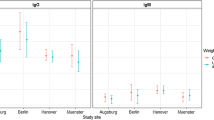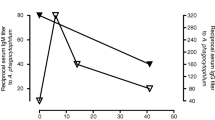Abstract
To investigate whether human granulocytic ehrlichiosis (HGE) is prevalent in Switzerland, 1515 human serum samples from individuals with different risks for tick exposure were tested for antibodies toEhrlichia phagocytophila, a surrogate marker of the agent of HGE. The distribution of titres showed marked differences between sera of individuals with no or low risk for tick exposure and those with a high risk. The results of serological testing provided evidence of HGE in Switzerland as well as evidence of two types of coinfections: those with the agent of HGE andBorrelia burgdorferi, and those with the agent of HGE and the central European tickborne encephalitis virus.
Similar content being viewed by others
References
Bakken JS, Krueth J, Wilson-Nordskog C, Tilden RL, Asanovich K, Dumler JS: Clinical and laboratory characteristics of human granulocytic ehrlichiosis. Journal of the American Medical Association (1996) 275:199–205.
Dumler JS, Dotevall L, Gustafson R, Granström M: A population-based seroepidemiologic study of human granulocytic ehrlichiosis and lyme borreliosis on the west coast of Sweden. Journal of Infectious Diseases (1997) 175:720–722.
Bakken JS, Krueth J, Tilden RL, Dumler JS, Kristiansen BE: Serological evidence of human granulocytic ehrlichiosis in Norway. European Journal of Clinical Microbiology & Infectious Diseases (1996) 15:829–832.
Sumption KJ, Wright DJM, Cutler SJ, Dale BAS: Human ehrlichiosis in the UK. Lancet (1995) 346:1487–1488.
Brouqui P, Dumler JS, Lienhard R, Brossard M, Raoult D: Human granulocytic ehrlichiosis in Europe. Lancet (1995) 346:782–783.
Petrovec M, Furlan SL, Zupanc TA, Strle F, Brouqui P, Roux V, Dumler JS: Human disease in Europe caused by a granulocyticEhrlichia species. Journal of Clinical Microbiology (1997) 35:1556–1559.
Dumler JS, Asanovich KM, Bakken JS, Richter P, Kimsey R, Madigan JE: Serologie cross-reactions amongEhrlichia equi, Ehrlichia phagocytophila, and human granulocytic Ehrlichia. Journal of Clinical Microbiology (1995) 33:1098–1103.
Pusterla N, Wolfensberger C, Gerber-Bretscher R, Lutz H: Comparison of indirect immunofluorescence forEhrlichia phagocytophila andEhrlichia equi in horses. Equine Veterinary Journal (1997) 29:490–492.
Nadal D, Hunziker UA, Bucher HU, Hitzig WH, Duc G: Infants born to mothers with antibodies againstBorrelia burgdorferi at delivery. European Journal of Pediatrics (1989) 148:426–427.
Truninger K, Bossart W, Vetter W: Fever and headache. Praxis (1996) 85:1180–1184.
Pusterla N, Huder J, Wolfensberger C, Litschi B, Parvis A, Lutz H: Granulocytic ehrlichiosis in two dogs in Switzerland. Journal of Clinical Microbiology (1997) 35:2307–2309.
Chen S-M, Dumler JS, Bakken JS, Walker DH: Identification of a granulocytotropicEhrlichia species as the etiologic agent of human disease. Journal of Clinical Microbiology (1994) 32:589–595.
Author information
Authors and Affiliations
Rights and permissions
About this article
Cite this article
Pusterla, N., Weber, R., Wolfensberger, C. et al. Serological evidence of human granulocytic ehrlichiosis in Switzerland. Eur. J. Clin. Microbiol. Infect. Dis. 17, 207–209 (1998). https://doi.org/10.1007/BF01691120
Issue Date:
DOI: https://doi.org/10.1007/BF01691120




